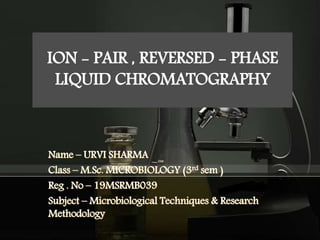
Ion pair , reversed pair liquid chromatography
- 1. ION - PAIR , REVERSED - PHASE LIQUID CHROMATOGRAPHY Name – URVI SHARMA Class – M.Sc. MICROBIOLOGY (3rd sem ) Reg . No – 19MSRMB039 Subject – Microbiological Techniques & Research Methodology
- 2. INTRODUCTION • Ion pair chromatography (IPC) is an effective reversed-phase liquid chromatographic (RPLC) technique for separation of organic ions and partly ionized organic analytes. • The purpose of adding an ion pair reagent to the mobile phase is usually to change the retention time of ionic analytes. • The technique utilizes the same types of stationary phases and mobile phases as RPLC; the main characteristic for IPC is that an ion pair reagent is added to the mobile phase. • The ion pair reagent is usually an alkylsulfonate, an alkylsulfate or an alkylammonium salt. • The high efficiency of RPC columns compared with columns used in ion exchange or ion chromatography also makes IPC a valuable alternative to these techniques. • IPC has been applied in almost all areas of analytical chemistry where chromatography is used.
- 3. Cont… • In IPC, water-rich mobile phases can be employed with a variety of buffers and ionic and non-ionic additives and the technique is therefore suitable for separation of important classes of biomolecules and specifically amino acids, peptides, proteins and nucleic acids. • In the food industry, IPC is used for the analysis of water- soluble vitamins, caffeine, theobromine, amines, etc. • Since many drugs are basic or acidic, the driving force for the development of IPC came from the pharmaceutical industry where today it is used on a routine basis. • Ion-pairing chromatography (IPC) can be used for both positively and negatively charged analytes. Negatively charged reagent can be used to retain positively charged ionic bases. Positively charged reagent can be used to retain negatively charged ionic acids.
- 4. lon Pair Reagent • Added to mobile phase at low concentration (usually 0.05M) and is itself ionized. • lon pair reagent are molecules containing a hydrophobic region and an ionizable functioality. • •One ion of the reagent is retained by the stationary phase providing the otherwise neutral stationary phase with its charge. • •This charged stationary phase can then retain and separate organic solute ions of the opposite charge by forming a reversible ion pair complex with the ionized sample. Example – RCOO- + R4N+ ---→ [R4N+-OOCR] ion pair
- 5. MECHANISM There are two fundamental models are as follow – 1) The solute molecule forms an ion pair with counter ion in the mobile phase. This uncharged ion pair partitions into the lipophilic stationary phase. 2) The counterion partitions into the stationary phase or is loaded onto the bonded reverse phase packing, with its ionic group oriented at the surface generating two possibilities: a) Analyte can be attracted to the hydrocarbon portion in the usual reverse phase monomer, or b) Analyte can interact in an ion exchange mode.
- 6. Cont… • True mechanism involves both the postulates and is further complicated by adsorption and micelle formation allowing the unique separation.
- 7. ADVANTAGES • IPC separation involves two additional variables that can be used for control of selectivity (IPC- reagent type and concentration) . • Simple preparation of buffers. • Wide choice of carbon chain lengths for improved retention and separation. • Significantly reduced separation time (vs. ion exchange). • Simultaneous separation of both ionized and non- ionized molecules. • High reproducibility of results. • Improved peak shapes. • Better separation of large ions (vs. ion exchange).
- 8. DISADVANTAGES • Greater complexity of operation and more challenging interpretation of results. (e.g., more variables to choose from or to control). • Slow column equilibration after changing the mobile phase. Specially slow when IPC reagent is more hydrophobic. Possible that not all of the IPC reagent will be washed from the column.
- 9. APPLICATION 1) Biological analysis Ion pair reverse phase chromatography: a versatile platform for the analysis of RNA. • Ability to separate large RNA molecules with higher resolution. • In addition to efficient isolation and analysis of RNA species, IP, RP, HPLC provides valuable structural information. 2) Food Analysis Determination of water-soluble vitamins in infant milk by High-Performance Liquid Chromatography. • Separation of molecules with different chemical properties such as stability, polarity, and acidity. • Can control pH and concentration of mobile phase. • Ability to separate multiple vitamins in a single run. • Better resolution in comparison to ion exchange chromatography.
- 10. APPLICATION 3) Pharmaceutical Analysis Separation and determination of impurities in paracetamol, codeine and pitophenone in the presence of fenpiverinium in combined suppository dosage form. • Can determine impurities in dosage form. • Sensitive- ability to measure low concentrations of analytes. • Great accuracy- highly reproducible results. • Manipulation in pH of buffer leads to better resolved peaks. • Improved peak shape
- 11. CONCLUSION • It is also known as ION INTERACTION or DYNAMIC ION EXCHANGE CHROMATOGRAPHY. • Based on the greater complexity of Ion-pair Chromatography compared to Reverse Phase Chromatography it is recommended that IPC should be considered only after RPC techniques are not effective. • Ion-pairing liquid chromatography is a promising means of increasing analyte retention.
- 12. REFERENCES J.Dolan. LCGC Europe, Volume 21, Issue 5, pp 258-263. L. Snyder, J. Kirkland, and J. Dolan. (2010). Introduction to Modern Liquid Chromatography 3rd Edition. Wiley & sons, Inc., Publications. (pages. 331-347). Vailaya, C. Horvath, J Chromatogr. A 829 (1998) 1–27. Dickman, M.J.Chromatography Today, 2011, 22-26. Erich, S.; Anzmann, T.; Fischer, L. J. Food chemistry, 2012, 135, 2393-2396. Vojta, J.; Hanzlíka, P.; Jedličkaa, A.; Coufal, P. J. Pharmaceutical and Biomedical Analysis, 2014, 102, 85-62. https://www.researchgate.net/publication/215520397_Ion- pair_reversed-phase_high- performance_liquid_chromatography_of_ondansetron_hydroc hloride_using_sodium_heptanesulphonate_as_a_counterion https://www.sciencedirect.com/topics/chemistry/ion-pair- chromatography
